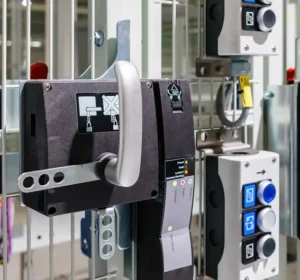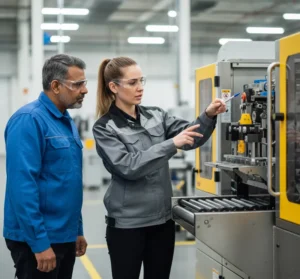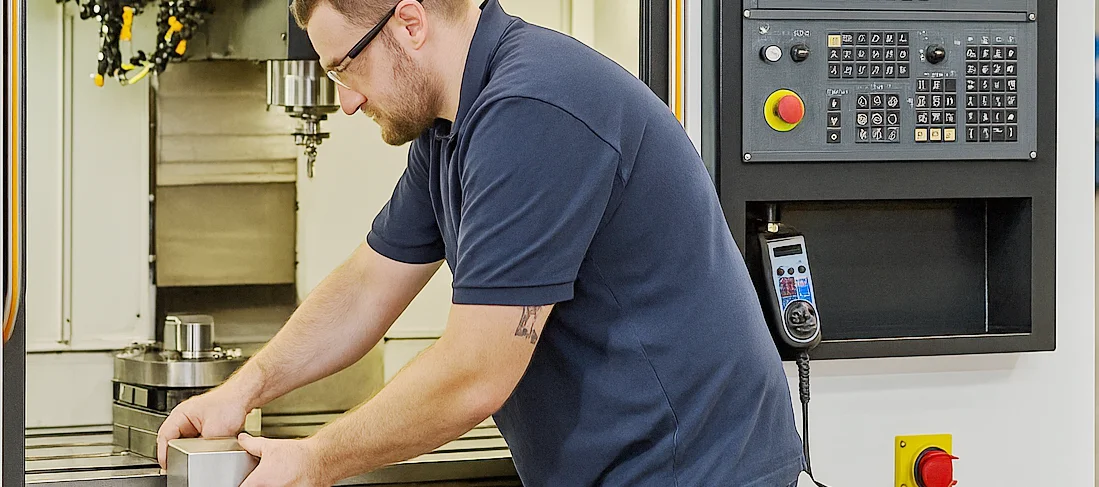Any UK business that owns, operates, or controls work equipment has a legal requirement to comply with the Provision and Use of Work Equipment Regulations 1998 (PUWER). What, then, are the PUWER regulations for machinery in sectors like manufacturing and warehousing? Enacted under the Health and Safety at Work etc. Act 1974, these regulations are the foundation of machinery safety in the workplace and are designed to protect everyone who comes into contact with equipment.
In this guide, we will cover:
- What equipment and activities the regulations apply to.
- The core regulations defining an employer’s main duties.
- The specific rules for machine guarding under Regulation 11.
- The difference between your duties (PUWER) and a manufacturer’s duties.
- How to apply the regulations through a risk assessment.
Understanding the Scope: What Do the Regulations Cover?
Before detailing the specific rules, it’s important to understand what they apply to. It’s a common misconception that PUWER only covers large, complex machinery.
In fact the regulations define ‘work equipment’ in extremely wide terms to include any tool, appliance, apparatus, or installation used at work. This scope covers everything from simple hand tools to robotic cells. It’s not well known that PUWER even includes equipment that employees provide for their own use.
The extent of the compliance burden is often underestimated. The regulations interpret ‘use’ broadly to cover the equipment’s entire lifecycle and functions within this, including starting, stopping, programming, setting, transporting, repairing, maintaining, cleaning and disposal.
The Core Regulations: An Employer’s Main Duties
The initial regulations within PUWER establish a holistic, interdependent system for managing work equipment safely.
Regulation 4: Suitability. This regulation requires that equipment is suitable for the purpose and the conditions in which it will be used. This demands a risk-based selection process that goes beyond simply checking for a UKCA or CE mark, since these alone do not guarantee suitability for your specific operational context.
Regulation 5: Maintenance states that equipment must be maintained in an efficient state and good repair to prevent danger. This requires a proactive approach, such as planned maintenance – during shutdowns for example – to ensure continuity of compliance. Where a machine has a maintenance log, it is a legal requirement to keep this updated.
Regulation 6: Inspection mandates formal inspections in three key situations: after installation, at suitable intervals if exposed to deterioration, and after exceptional circumstances like major modifications or damage. According to PUWER, a “competent person” with the necessary knowledge must perform these inspections and the results must be recorded.
Regulations 8 and 9: Information and Training. These regulations cover human interaction with machinery. All users must receive adequate health and safety information, instructions, and warnings. Furthermore, every person who uses, supervises, or manages equipment must receive adequate training on its correct use, the risks involved, and the necessary precautions.
 Regulation 11: The Critical Rules for Guarding Dangerous Parts
Regulation 11: The Critical Rules for Guarding Dangerous Parts
Regulation 11 is arguably the most critical for preventing severe injuries. It places an absolute duty on employers to take effective measures to prevent access to any dangerous part of machinery. The regulations establish a clear hierarchy of controls and safety measures to achieve this:
- Fixed Guards: Where appropriate, the preferred solution is a physical barrier that is permanently attached and can only be removed with tools.
- Other Guards and Protection Devices: Where routine access is needed, solutions such as interlocked guards (which stop the machine when opened) or devices like light curtains, designed to stop machinery when a person enters the area around it, are required.
- Protection Appliances: If guards cannot provide full protection, appliances such as jigs, holders, and push-sticks must be used to keep the operator’s hands away from the danger zone.
- Information, Instruction, Training, and Supervision: These are the final layers of protection, used to control any risk that engineering controls cannot eliminate.
For a detailed look at the different types of safety systems available, including fixed guards and protection devices, visit our dedicated machine guarding page.
Failure to follow these rules can have very serious consequences. A single non-compliance, for example a guard being too short to comply with standard reach distances, can lead directly to a life-changing injury or even a fatality, with the company facing prosecution.
A Key Distinction: PUWER vs. a Manufacturer’s Regulations (SMSR)
A frequent point of confusion is the difference between an employer’s duties under PUWER and a manufacturer’s duties under the Supply of Machinery (Safety) Regulations 2008 (SMSR).
- SMSR governs the supply of new machinery. A manufacturer must design and construct a safe machine, evidenced by a UKCA mark.
- PUWER governs the use of all machinery. The employer must ensure the machine is safe as it is installed, used, and maintained in situ.
A UKCA or CE mark only attests that the machine was safe when it left the factory. It does not account for how it is installed, used, and maintained in situ. This is why a machine can be safe “on the lorry” but become unsafe “on the line” without a proper PUWER assessment by the employer.
Applying the Regulations: From Risk Assessment to Action
 The cornerstone of applying these regulations is a formal risk assessment. To be effective, this must be a practical exercise, not just a paper one. The process involves six key steps:
The cornerstone of applying these regulations is a formal risk assessment. To be effective, this must be a practical exercise, not just a paper one. The process involves six key steps:
- Identify the hazards: What parts, processes, or substances could cause harm?
- Decide who might be harmed and how: Consider operators, maintenance staff, cleaners, and others in the vicinity.
- Evaluate the risks and decide on precautions: Determine the likelihood and severity of harm and identify appropriate control measures, following the hierarchy of controls.
- Act on the findings: Implement the precautions you have identified. If non-compliance is found–-especially during installation and commissioning–-you must act. This is where expert help becomes invaluable for translating results into practical engineering solutions.
- Keep a record: Document the assessment, the precautions taken, and any further actions.
- Review and update: Keep the assessment as a living document, reviewed periodically or when there are significant changes.
A common failing is the “compliance gap” – a difference between documented procedures and the reality on the shop floor. A thorough, practical assessment, followed by corrective action, is the only way to find and close this gap.
Frequently Asked Questions (FAQs)
Q: Is a UKCA or CE mark enough for PUWER compliance? A: No. A UKCA or CE mark shows the machine was safe when it was supplied by the manufacturer, which is their duty under the Supply of Machinery (Safety) Regulations (SMSR). PUWER is the employer’s separate and ongoing duty to ensure the machine remains safe as it is installed, used, and maintained in their specific workplace.
Q: What is the key difference between PUWER and the SMSR? A: The simplest way to see it is that SMSR governs the supply of a machine, while PUWER governs its entire lifecycle of use. The manufacturer is responsible for SMSR compliance when they place the machine on the market. The employer is responsible for PUWER compliance from the moment the machine arrives at their site until it is disposed of.
Q: What value can a consultant add to the PUWER compliance process? A: An expert consultant adds value by translating the legal requirements of PUWER into practical, real-world engineering solutions. They can perform an impartial and thorough risk assessment, identify the ‘compliance gaps’ that an in-house team might overlook, and design and implement the most effective control measures–-such as compliant guarding or updated safety circuits–-to rectify any issues found.
Q: Who can perform a PUWER inspection? A: A PUWER inspection must be carried out by a “competent person.” This is someone who has the necessary practical and theoretical knowledge and actual experience of the equipment to enable them to identify defects or weaknesses and assess how important they are in relation to the safety and continued use of the equipment.
Q: Does PUWER apply to hand tools? A: Yes. The regulations define ‘work equipment’ in extremely wide terms to include any tool or appliance used at work. This means that everything from simple hand tools and ladders to complex production lines is covered by PUWER.
Partner with the Experts for Robust and Compliant Machinery Safety
Meeting your duties under PUWER is a non-delegable responsibility that is fundamental to protecting your workforce. It requires a detailed understanding of these regulations and a practical approach to risk management.
We can help you close the compliance gap and ensure your machinery is not just compliant, but fundamentally safe and productive.


